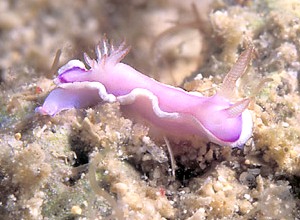
Thorunna halourga
Johnson & Gosliner, 2001
DISTRIBUTION
Tropical western Pacific - sthn Japan, Philippines, Marshall Ids, Papua New Guinea, eastern Australia
PHOTO
Anilao, Luzon Island, Philippines, April, 2002. Approx 7mm long. Photo: Jeff Rosenfeld.
This is another small species in the Noumea purpurea colour group growing to about 12 mm long. The mantle is a pale lilac becoming purple in front of the rhinophores and behind the gills. The mantle margin, which is slightly undulate, has a broad white band. The rhinophores have a purple stalk and the lamellae are edged with orange. The gills are white with orange axes. Because of its similarity in colour to other species it is difficult to be sure of identifying records from colour photos alone, but it appears to have been found in Papua New Guinea, the Philippines, and tropical eastern Australia.
References:
• Johnson, R.F. & Gosliner, T.M. 2001. Two new species of Thorunna Bergh 1878 (Mollusca: Nudibranchia: Chromodorididae) from the Indo-Pacific. Bollettino Malacologico ,37(5-8): 143-150.
• Marshall, J.G. & Willan, R.C. 1999. Nudibranchs of Heron Island, Great Barrier Reef: a survey of the Opisthobranchia (Sea Slugs) of Heron and Wistari Reefs. Leiden, Backhuys Publishers. [as Thorunna sp. 1]
Rudman, W.B., 2002 (December 11) Thorunna halourga Johnson & Gosliner, 2001. [In] Sea Slug Forum. Australian Museum, Sydney. Available from http://www.seaslugforum.net/find/thorhalo
Related messages
Re: On the Noumea purpurea Colour Group
March 5, 2009
From: N.Barbara Hanchard
Concerning message #22289:
Bill and others,
Scott thanks for the revised ID (Thorunna halourga ) and Gary for the comment on the egg laying side. The photo was taken with a digital SLR using a 105 mm lens so it isn't slide and there is no reversal. Unfortunately I couldn't get a shot of the right side of the slug where you would expect to see the genital opening. All I can think of is that the light pinkish streak that Bill thinks is the final bit of the egg material being extruded from the genital opening isn't and is maybe just variable colouring of the mantle.
Barbara
nbhanchard@gmail.com
Hanchard, N.B., 2009 (Mar 5) Re: On the Noumea purpurea Colour Group. [Message in] Sea Slug Forum. Australian Museum, Sydney. Available from http://www.seaslugforum.net/find/22308Dear Barbara,
Thanks for clearing that up. Concerning the lighter coloured material, I still thnk it is probably a bit of 'extra material' being extruded from the genital opening. In my earlier answer to Gary's comment I had already decided the genital opening was on the 'blind' side. So what I was trying to say -but obviously not very clearly - is that sometimes a bit of waste yoke and egg material can be extruded after egg laying and I suspect if we could see the other side of the animal we would see the other end of that light pinkish streak exiting the genital opening. In extreme conditions, all stressed animals are able to produce is incomplete ribbons, much like the extra 'waste' your animal appears to have produced. Usually there are no eggs, or just a few loose eggs, and streaks of yolk.
Best wishes,
Bill Rudman
Re: On the Noumea purpurea Colour Group
February 27, 2009
From: Gary Cobb
Concerning message #22276:
Hi Bill and everyone!
In these photos, am I seeing the genital opening on the left side of the body? Or are the photos flopped?
Cheers
Gary
gary@nudibranch.com.au
Cobb, G, 2009 (Feb 27) Re: On the Noumea purpurea Colour Group. [Message in] Sea Slug Forum. Australian Museum, Sydney. Available from http://www.seaslugforum.net/find/22289Thanks Gary,
I wondered that myself, but then decided it was just the edge of the foot folding around a stick. With the increased use of digital cameras, the old problem of reversing slides during scanning doesn't seem to arise very often these days. Perhaps Barbara can put our minds to rest.
Best wishes,
Bill Rudman
Re: On the Noumea purpurea Colour Group
February 27, 2009
From: Scott Johnson
Concerning message #22276:
Hi Bill,
Barbara's animal also looks like Thorunna halourga.
Scott
uwkwaj@yahoo.com
Johnson, S., 2009 (Feb 27) Re: On the Noumea purpurea Colour Group. [Message in] Sea Slug Forum. Australian Museum, Sydney. Available from http://www.seaslugforum.net/find/22290Thanks Scott,
I agree. For some reason I seem to have a blind spot for T. halourga.
Best wishes,
Bill Rudman
Re: On the Noumea purpurea Colour Group
February 26, 2009
From: N. Barbara Hanchard
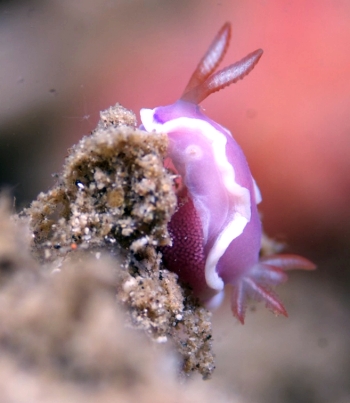
Note added 27 Feb 2009: This is probably Thorunna halourga . See message #22290.
Bill,
I am tempted to place this slug in your grouping of Noumea purpurea colour grouping except for one thing. Any central striping or colouration is absent in this slug. It was very small (5 mm) and appears to be laying an egg ribbon but as you say unless you can actually see the ribbon being laid its possible that the slug is transiting over. This slug was pretty stationary though.
Locality: Leilei, Honiara, 18 meters, Solomon Islands, Pacific, 21 February 2009, sandy slope. Length: 5 mm. Photographer: N.Barbara Hanchard.
Barbara
nbhanchard@gmail.com
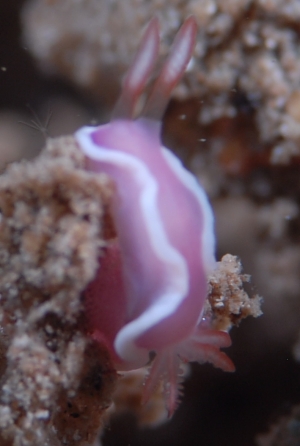
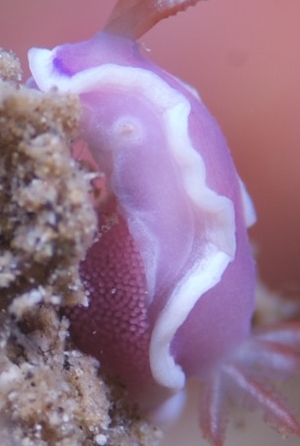
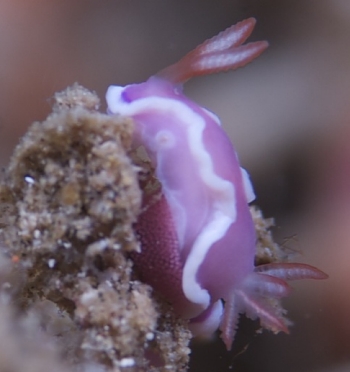
Dear Barbara,
From the way the edge of the mantle is developed into lobes and the gemeral colour, I am pretty sure this is Noumea varians. It lacks any trace of white streaks down the midline, but we have a photo of an animal from Japan [message #12247] which I also suspect is N. varians. Of course, as I have said before, this Noumea purpurea group of species has caused me grief - or at least surprises - in the past, so the only sure way to identify species is to dissect them and look at their anatomy. The egg ribbon could well be this species. The light pinkish streak we can see in the close-up [middle right photo] could well be the final bit of egg material being extruded from the genital opening.
Best wishes,
Bill Rudman
Thorunna halourga from Japan.
February 19, 2004
From: Kunihiro Takahashi
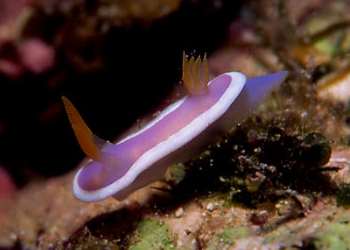
Dear Dr.Rudman
I found this slug and two similar ones [message #12247, message #12248] at Okinawa.
Are they Hypselodoris bullocki?
Data
Date: 26 May, 2001
Location: Cape Maeda,Okinawa Japan
Depth: 10m
Length: 8~10mm
W/Temp: 25C degree
Photo by Kunihiro Takahashi
Best Regards,
Kunihiro Takahashi
manta9216@tontonme.ne.jp
Takahashi, K., 2004 (Feb 19) Thorunna halourga from Japan.. [Message in] Sea Slug Forum. Australian Museum, Sydney. Available from http://www.seaslugforum.net/find/12158Dear Kunihiro,
Your three slugs all looke quite like H. bullocki, but they are three different species. I can't be 100% certain of my identifications because we don't know very much about colour variations in any of these species. In fact we only discovered that some of them were distinct species after we had looked at their anatomy and the shape of their radular teeth.
I am pretty sure this one is Thorunna halourga. Some of this group of similarly coloured species can be seen on a separate page, but since I prepared that page, more similarly coloured species have turned up and need to be added
Best wishes
Bill Rudman
Thorunna halourga from Philippines
January 20, 2003
From: Jeff Rosenfeld

Hi Bill,
Here's a shot of Thorunna halourga taken in Anilao, Luzon Island, Philippines in April, 2002. This specimen must have been in the neighborhood of about 7mm. I noticed you don't yet have a page for this species.
Thanks,
Jeff
jhrosenfeld@seattleschools.org
Rosenfeld, J., 2003 (Jan 20) Thorunna halourga from Philippines. [Message in] Sea Slug Forum. Australian Museum, Sydney. Available from http://www.seaslugforum.net/find/8664Thanks Jeff,
I haven't yet seen this publication. Our library gets the journal on an exchange arrangement, and sometimes this can be very slow. With haven't had a copy of Bollettino Malacologico for about 5 years!
Bill Rudman
Re: Thorunna halourga from Philippines
January 20, 2003
From: Scott Johnson
Hi Bill,
There are some more photos of Thorunna halourga under the name Thorunna cf speciosus.
Scott
johnson@kmr.LL.mit.edu
Thanks Scott,
I'm glad someone's alert! I've moved all the messages.
Bill Rudman
Thorunna from Heron Island
July 12, 2001
From: Julie Marshall
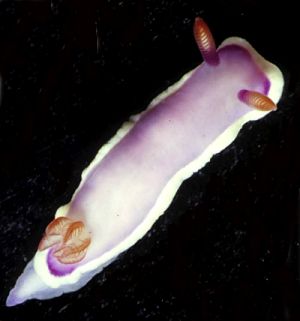
Dear Bill,
I was interested in Rebecca Johnson's picture of a new Thorunna species that she and Terry Gosliner are describing. It seems to be the species that Richard Willan and I have illustrated in our book on Heron Island nudibranchs as Thorunna sp. 1. I have found six specimens of this species. The pictured animal was 12 mm in size although most of the others have been from 5 to 7 mm. It was found at low tide at the reef crest under a dead coral slab in January 1993.
Best wishes
Julie Marshall
j.marshall@latrobe.edu.au
Marshall, J., 2001 (Jul 12) Thorunna from Heron Island. [Message in] Sea Slug Forum. Australian Museum, Sydney. Available from http://www.seaslugforum.net/find/4799Note: Previously on the Forum as Thorunna cf. speciosus this is now named Thorunna halourga.
Thanks Julie,
It certainly seems to have a wide distribution.
Best wishes,
Bill Rudman
Re: Thorunna? cf. speciosus
July 7, 2001
From: Rebecca Johnson
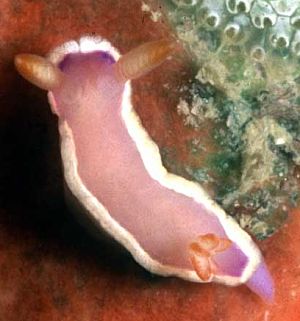
Hi Bill,
This beautiful little guy is a new species of Thorunna. Alas, the name will have to remain as sp. (I would hate for someone to consider my little note a description.) until publication It is described in Terry and my forthcoming paper in the proceedings from the Opisthobranch meeting in Menfi. So, look for all the details about it (hopefully soon!!) in the Bolletino Malacologico. I will send some details about my talk at the WSM meeting soon.
Thanks,
Rebecca.
rjohnson@calacademy.org
Johnson, R., 2001 (Jul 7) Re: Thorunna? cf. speciosus. [Message in] Sea Slug Forum. Australian Museum, Sydney. Available from http://www.seaslugforum.net/find/4741Note: Previously on the Forum as Thorunna cf. speciosus this is now named Thorunna halourga.
Thanks Rebecca,
It's nice to confirm its genus. I remember your interesting talk at Menfi but must confess to not remembering your photo of this species.
Best wishes,
Bill Rudman
Hypselodoris bullocki or Noumea sp.?
July 3, 2001
From: Yasuhiro Shirai
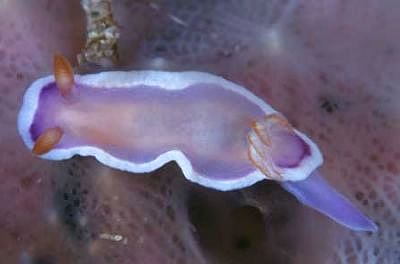
Dear Bill,
Thanks for all your answers to my messages. Today, I have attached an image file which
I think is Hypselodoris bullocki or a species of Noumea [Noumea purpurea Colour group].
When I found this animal, it crawled on sponges./Could you please identify it for me?
Location:Kushimoto Pref. Wakayama Japan(Kii Peninsula) Length: about 10mm
Water temperature: 21C
Date Jun. 2001
Depth: 16m
PS.My opisthobranchs website has moved from:
http://www.e-net.or.jp/user/yasuhiro/diving/aquarium/umiusi/ to http://www.sea-slug.com/
Best regards,
Yasuhiro Shirai
yasuhiro@sea-slug.com
Yasuhiro Shirai, 2001 (Jul 3) Hypselodoris bullocki or Noumea sp.?. [Message in] Sea Slug Forum. Australian Museum, Sydney. Available from http://www.seaslugforum.net/find/4631Note: Previously on the Forum as Thorunna cf. speciosus this is now named Thorunna halourga.
Dear Yasuhiro
This is the animal I am calling Thorunna cf speciosus. Another one of the Noumea purpurea colour group.
Best wishes,
Bill Rudman
Thorunna cf. speciosus
June 12, 2000
From: Scott Johnson
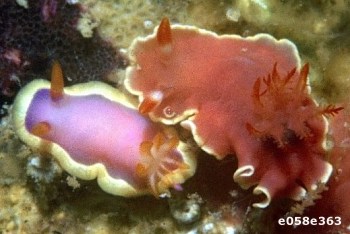
Hi Bill,
Enewetak Atoll in the Marshall Islands has a species that appears to be the same as the Thorunna cf speciosus found by Atsushi Ono in Japan. Attached are several shots of what I believe to be all one species, even though the marginal coloration varies from white to yellow. A dozen specimens observed at Enewetak ranged in size from 6 to 16mm, the largest developing ruffled margins as shown in photo e058-7. The gills were vibratile. Dissections of the radula reveal typical Thorunna teeth with innermost laterals long and narrow (although wider at the base) and trifid at the tips, and remaining laterals narrower and bifid at the tips.
In one of the shots, [e058e363], the Thorunna (on the left) is shown next to a species of Noumea that happened to be living on pink sponge under the same rock.
Scott
johnson@kmrmail.kmr.ll.mit.edu
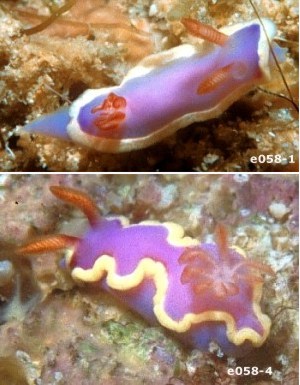
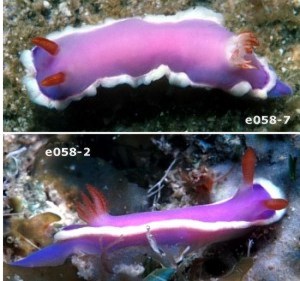
Note: Previously on the Forum as Thorunna cf. speciosus this is now named Thorunna halourga.
Thanks Scott,
I notice that Marshall & Willan, 1999 record it as Thorunna sp. 1 from Heron Island, Great Barrier Reef.
Best wishes,
Bill Rudman.
Thorunna cf speciosus? from Japan
June 9, 2000
From: Atsushi Ono
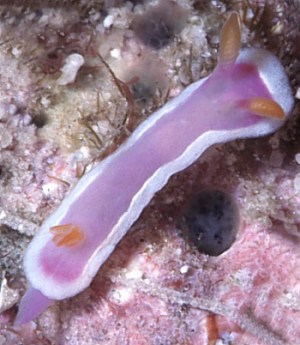
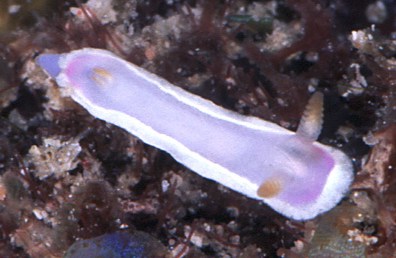
Dear Bill,
Here are chromodorid photos of different individuals. They are very small, the UPPER PHOTO is 7mm long, the LOWER is 5mm long.
I found them at 5m depth on a coral reef in May and Oct. 1999, at Kerama Is. near Okinawa in Japan.
Is this color variation of Thorunna speciosus?
PS. I have sent a photo separately, of an animal I think is Thorunna speciosus from the area.
Sincerely,
Atsushi Ono
ononini@cosmos.ne.jp
Ono, A., 2000 (Jun 9) Thorunna cf speciosus? from Japan. [Message in] Sea Slug Forum. Australian Museum, Sydney. Available from http://www.seaslugforum.net/find/2466Note: Previously on the Forum as Thorunna cf. speciosus this is now named Thorunna halourga.
Dear Atsushi,
It certainly looks a bit like Thorunna speciosus but the white border all around the mantle edge is certainly different. It is possibly a species of Thorunna but we could only be sure if that by looking at its anatomy.
Best wishes,
Bill Rudman.
